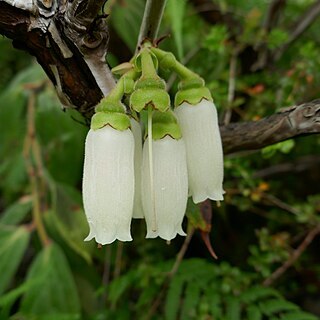Trees up to 10 m, shrubs, large lianas, or epiphytic, stem base and roots not rarely thickened. Leaves spiral, petioled, entire or with minute crenations or teeth ending in a callous caducous setular hair or gland, ± coriaceous, plinerved ± from the base, with a basal, thickened, marginal gland on each side near the petiole. Flowers mostly large and showy, in (1-)few-many-flowered axillary or rami-cauliflorous fascicles or short racemes. Buds of inflorescences subglobular-ovoid, with numerous, concave, early caducous perulae. Pedicels ± distinctly articulate at both ends. Bracteoles 2, subbasal, mostly small. Calyx tube adnate to the ovary, cylindrical to semiglobose, very rarely with 5 angles or ribs alternating with the lobes. Corolla tubular to campanulate, 5-lobed. Stamens (8-)10, alternately unequally long and dimorphous; major stamens: filaments linear, dorsifixed; anther-cells oblong, mostly granular, at base not rarely beaked, sometimes bearing a small anchor-like appendage, or a tuft of hairs, at apex extending into a ± ear-shaped tubule splitting introrsely; connective often produced at apex into 2 processes; processes fixed in the gap between the tubules or fixed behind them, sometimes in various degree adnate to the back of the tubules (except at the tip); minor stamens: in all parts shorter than the major stamens. Disk annular. Style slender, often exserted; stigma truncate or minutely lobed. Fruit baccate, 5-celled, (sub)globular, ∞-seeded, with the persistent calyx limb. Seeds ellipsoid, small; testa reticulate.
More
Calyx tube ± terete or smooth, not winged or ribbed. Corolla much dilated distally, i.e. campanulate or more rarely widely urceolate at full maturity, rather deeply 5-lobed to (1/5-)1/4-1/2 of the total length of the corolla.
Calyx tube ± terete or smooth, not winged or ribbed. Corolla tubular, but slightly or not dilated distally, shortly lobed, lobes up to 1/5 as long as the total corolla.
Calyx conspicuously 5-winged or-ribbed, the wings or ribs alternating with the calyx lobes. Corolla tubular.
Predominantly in the upper (moss) forest or forest edge with grassland, 1300-3560 m, rarely in low country upwards of 75 m. The highest altitude is reached by D. alpivaga, a small shrub in the alpine savannah of Mt Carstensz at 3700-4300 m. A few spp. are found both epiphytically in patches of mossy forest and terrestrial in adjacent grassland.
Uses. In New Guinea the flowers are occasionally used for ornamental purposes by Papuans, as can be observed from the colour picture published by E.Th. Gilliard Nat. Geogr. Mag. 1951 669 , which probably shows D. amoena.

